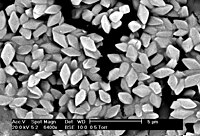
Photo from wikipedia
HIGHLIGHTSCry1Ab and Cry2Ab toxins do not share binding sites in Manduca sexta.Cry2Ab does not bind ALP or cadherin proteins.Cry2Ab binds APN2. ABSTRACT Bacillus thuringiensis Cry2Ab toxin has been used in… Click to show full abstract
HIGHLIGHTSCry1Ab and Cry2Ab toxins do not share binding sites in Manduca sexta.Cry2Ab does not bind ALP or cadherin proteins.Cry2Ab binds APN2. ABSTRACT Bacillus thuringiensis Cry2Ab toxin has been used in combination with Cry1Ac for resistance management on the Bt‐cotton that is widely planted worldwide. However, little is known regarding Cry2Ab mode of action. Particularly, there is a gap of knowledge on the identification of insect midgut proteins that bind Cry2Ab and mediate toxicity. In the case of Cry1Ab toxin, a transmembrane cadherin protein and glycosyl‐phosphatidylinositol (GPI) anchored proteins like aminopeptidase‐N1 (APN1) or alkaline‐phosphatase (ALP) from Manduca sexta, have been shown to be important for oligomer formation and insertion into the membrane. Binding competition experiments showed that Cry2Ab toxin does not share binding sites with Cry1Ab toxin in M. sexta brush border membrane vesicles (BBMV). Also, that Cry2Ab shows reduced binding to the Cry1Ab binding molecules cadherin, APN1 or ALP. Finally, ligand blot experiments and protein sequence by LC‐MS/MS identified APN2 isoform as a Cry2Ab binding protein. Cloning and expression of APN2 confirmed that APN2 is a Cry2Ab binding protein.
Journal Title: Peptides
Year Published: 2017
Link to full text (if available)
Share on Social Media: Sign Up to like & get
recommendations!